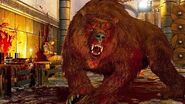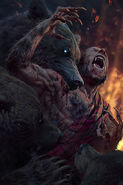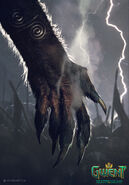m (→Bestiary entry: clean up) |
m (→Combat Tactics: clean up) |
||
| (14 intermediate revisions by 5 users not shown) | |||
| Line 1: | Line 1: | ||
| − | {{DisambigMsg|This article is about = humans able to transform into bears|For = the organization|see = Vildkaarl|For second page = {{Tw2}} skill|see second page = Berserker (skill)}} |
+ | {{DisambigMsg|This article is about = humans able to transform into bears|For = the organization|see = Vildkaarl|For second page = {{Tw2}} skill|see second page = Berserker (skill)}} |
| + | {{Infobox Race |
||
| ⚫ | '''Werebears''',<ref name="sos">{{SoS}}</ref> |
||
| + | |Image = Gwent cardart skellige bear abomination.jpg |
||
| − | {{Clear}} |
||
| + | |Aka = ''Berserker''<br>''Arctanthrope''?<ref group=N>So far, [[Andrzej Sapkowski]] tended to use real world Greek names for his werecreatures, such as ''lycanthrope'' for a [[werewolf]] and ''[[therianthrope]]'' as a term encompassing all such beasts. ''Arctanthrope'' is a Greek term for a werebear, but hasn't appeared in the books yet.</ref> |
||
| + | |Classification = [[Therianthrope]] |
||
| + | }} |
||
| ⚫ | |||
| + | |||
| + | Like other kinds of therianthropy, the "arctanthropy" can be acquired either as a result of a [[curse]] or inherited from werebear parents. However, it is likely that a bite from a werebear does not result in the victim becoming a werebear as well.<ref name="sos" /><ref name="wgw">{{WGW}}</ref><ref name="ros">{{Comics|Comic=ros}}</ref> That said, on the Skellige Isles, a group of [[Svalblod]] worshipers called [[Vildkaarl]]s invented another, "controllable" way of becoming a berserker. After a complicated ritual involving [[psilocybe]] mushrooms and what seemed to be allowing wild bears to eat the cultists alive, the fierce warriors used to rise and spill blood in the name of their god. |
||
| + | |||
| + | The bloodlust of Svalblod worshipers and their leader, jarl [[Knut the Callous]], ultimately led the Islanders to banish the cult and destroy the sacred sites of the werebear god.<ref name="tw3" /><ref name="gwent">{{Gwent standalone}}</ref> |
||
| + | |||
| + | Werebears are exceptionally strong, even tougher and more relentless than real bears.<ref name="tw3" /> It is possible that they enjoy the company of ursines, such as [[werewolf|werewolves]] stick to canines, [[werecat]]s to felids and [[wererat]]s to murids.<ref name="wgw" /><ref name="ros" /> |
||
== {{Tw3}} == |
== {{Tw3}} == |
||
| Line 10: | Line 20: | ||
|Class = [[Cursed one]] |
|Class = [[Cursed one]] |
||
|Occurrence = [[Skellige]]<br>[[Fornhala|Vildkaarls' village]] |
|Occurrence = [[Skellige]]<br>[[Fornhala|Vildkaarls' village]] |
||
| − | |Susceptibility = [[Devil's Puffball]]<br>[[Cursed oil]]<br>[[ |
+ | |Susceptibility = [[Devil's Puffball]]<br>[[Cursed oil]]<br>[[Quen]]<br>[[Igni]] |
|Loot = [[Bear fat]]<br>[[Berserker hide]]<br>[[Raw meat]] |
|Loot = [[Bear fat]]<br>[[Berserker hide]]<br>[[Raw meat]] |
||
}}Reading [[The Bear Legend]] provides a bestiary entry. |
}}Reading [[The Bear Legend]] provides a bestiary entry. |
||
| − | === Bestiary |
+ | === Bestiary Entry === |
: ''Now finish your soup, or a berserker'll come and swallow ye whole.<br>– Skellige mother scolding a child.'' |
: ''Now finish your soup, or a berserker'll come and swallow ye whole.<br>– Skellige mother scolding a child.'' |
||
: ''Skellige legends speak of men known as berserkers who transform into bears when overwhelmed by battle rage. In doing so, they lose all self-awareness and are driven by a bloodlust which they must satiate in order to return to human form. Few believe these blood-curdling tales, however, not even in Skellige, where the inhabitants usually treat even the least probable legends with the utmost gravity. This indicates either that berserkers are in fact mere figments of mead-sodden imaginations, or else that they have learned to hide their abilities from the rest of the islanders.'' |
: ''Skellige legends speak of men known as berserkers who transform into bears when overwhelmed by battle rage. In doing so, they lose all self-awareness and are driven by a bloodlust which they must satiate in order to return to human form. Few believe these blood-curdling tales, however, not even in Skellige, where the inhabitants usually treat even the least probable legends with the utmost gravity. This indicates either that berserkers are in fact mere figments of mead-sodden imaginations, or else that they have learned to hide their abilities from the rest of the islanders.'' |
||
| Line 20: | Line 30: | ||
: ''If these men-turned-bears truly do exist, one can suppose that, like werewolves and lycanthropes, they are particularly vulnerable to oils that harm cursed creatured. But if we are to give credence to ancient songs about these creatures' deeds, about the mass murders and massacres they have committed, we can only hope that no witcher will have to test this hypothesis.'' |
: ''If these men-turned-bears truly do exist, one can suppose that, like werewolves and lycanthropes, they are particularly vulnerable to oils that harm cursed creatured. But if we are to give credence to ancient songs about these creatures' deeds, about the mass murders and massacres they have committed, we can only hope that no witcher will have to test this hypothesis.'' |
||
| − | === Combat |
+ | === Combat Tactics === |
A berserker starts out as a human, when filled with the rage of battle, it transforms into a berserker (a form of bear). While in human form [[The Witcher 3 steel swords|steel swords]] along with [[Hanged Man's Venom]] will work well against them, as well as any tactics learned while fighting other humans. However, once they are transformed into their bear form, a [[silver sword]], that has been tainted with [[Cursed oil]], will work best. |
A berserker starts out as a human, when filled with the rage of battle, it transforms into a berserker (a form of bear). While in human form [[The Witcher 3 steel swords|steel swords]] along with [[Hanged Man's Venom]] will work well against them, as well as any tactics learned while fighting other humans. However, once they are transformed into their bear form, a [[silver sword]], that has been tainted with [[Cursed oil]], will work best. |
||
| − | Beyond the anatomical differences, a berserker's bear form should be treated just like fighting a true-born [[Bear]], save that these bears are much tougher, more relentless and harder to kill. If you have spent time improving your [[Igni |
+ | Beyond the anatomical differences, a berserker's bear form should be treated just like fighting a true-born [[Bear]], save that these bears are much tougher, more relentless and harder to kill. If you have spent time improving your [[Igni]] sign, the melt [[Armor]] [[Enhancements|enhancement]] will come in real handy here. If you have this available, make sure to activate it prior to dealing with a berserker. |
| − | === Associated |
+ | === Associated Quest === |
* [[King's Gambit]] |
* [[King's Gambit]] |
||
| Line 44: | Line 54: | ||
Gwent cardart skellige primal savagery.jpg|Gwent card art (claws) |
Gwent cardart skellige primal savagery.jpg|Gwent card art (claws) |
||
</gallery> |
</gallery> |
||
| + | |||
| + | == Footnotes == |
||
| + | <references group="N" /> |
||
== References == |
== References == |
||
<references /> |
<references /> |
||
| − | |||
{{Tw3 bestiary}} |
{{Tw3 bestiary}} |
||
| Line 54: | Line 66: | ||
[[ru:Берсерк]] |
[[ru:Берсерк]] |
||
[[uk:Берсерк]] |
[[uk:Берсерк]] |
||
| + | [[cs:Mědvědodlak]] |
||
[[Category:The Witcher 3 bestiary]] |
[[Category:The Witcher 3 bestiary]] |
||
| + | [[Category:Creatures]] |
||
Revision as of 16:15, 25 March 2020
| This article is about humans able to transform into bears. For the organization, see Vildkaarl. For The Witcher 2: Assassins of Kings skill, see Berserker (skill). |
Werebears,[1] on Skellige known as berserkers,[2] are therianthropes who transform into bears or half-bears. As other such creatures, they are hardly hurt by steel but are still very vulnerable to silver.
Like other kinds of therianthropy, the "arctanthropy" can be acquired either as a result of a curse or inherited from werebear parents. However, it is likely that a bite from a werebear does not result in the victim becoming a werebear as well.[1][3][4] That said, on the Skellige Isles, a group of Svalblod worshipers called Vildkaarls invented another, "controllable" way of becoming a berserker. After a complicated ritual involving psilocybe mushrooms and what seemed to be allowing wild bears to eat the cultists alive, the fierce warriors used to rise and spill blood in the name of their god.
The bloodlust of Svalblod worshipers and their leader, jarl Knut the Callous, ultimately led the Islanders to banish the cult and destroy the sacred sites of the werebear god.[2][5]
Werebears are exceptionally strong, even tougher and more relentless than real bears.[2] It is possible that they enjoy the company of ursines, such as werewolves stick to canines, werecats to felids and wererats to murids.[3][4]
The Witcher 3: Wild Hunt
Reading The Bear Legend provides a bestiary entry.
Bestiary Entry
- Now finish your soup, or a berserker'll come and swallow ye whole.
– Skellige mother scolding a child. - Skellige legends speak of men known as berserkers who transform into bears when overwhelmed by battle rage. In doing so, they lose all self-awareness and are driven by a bloodlust which they must satiate in order to return to human form. Few believe these blood-curdling tales, however, not even in Skellige, where the inhabitants usually treat even the least probable legends with the utmost gravity. This indicates either that berserkers are in fact mere figments of mead-sodden imaginations, or else that they have learned to hide their abilities from the rest of the islanders.
- The skalds' ballads indicate a berserker transformed in the heat of battle cannot be distinguised from a true-born bear. Only minute anatomical details - such as the shape of their tongues and teeth - reveal their secret. Descriptions of their fighting prowess paint them as invulnerable to pain and able to heal any wound received almost at once.
- If these men-turned-bears truly do exist, one can suppose that, like werewolves and lycanthropes, they are particularly vulnerable to oils that harm cursed creatured. But if we are to give credence to ancient songs about these creatures' deeds, about the mass murders and massacres they have committed, we can only hope that no witcher will have to test this hypothesis.
Combat Tactics
A berserker starts out as a human, when filled with the rage of battle, it transforms into a berserker (a form of bear). While in human form steel swords along with Hanged Man's Venom will work well against them, as well as any tactics learned while fighting other humans. However, once they are transformed into their bear form, a silver sword, that has been tainted with Cursed oil, will work best.
Beyond the anatomical differences, a berserker's bear form should be treated just like fighting a true-born Bear, save that these bears are much tougher, more relentless and harder to kill. If you have spent time improving your Igni sign, the melt Armor enhancement will come in real handy here. If you have this available, make sure to activate it prior to dealing with a berserker.
Associated Quest
Videos
Gallery
Footnotes
- ↑ So far, Andrzej Sapkowski tended to use real world Greek names for his werecreatures, such as lycanthrope for a werewolf and therianthrope as a term encompassing all such beasts. Arctanthrope is a Greek term for a werebear, but hasn't appeared in the books yet.
References
- ↑ 1.0 1.1 Season of Storms
- ↑ 2.0 2.1 2.2 The Witcher 3: Wild Hunt
- ↑ 3.0 3.1 Wiedźmin: Gra Wyobraźni
- ↑ 4.0 4.1 Reasons of State
- ↑ Template:Gwent standalone
| The Witcher 3 bestiary in The Witcher 3: Wild Hunt | |||||||||||||||||
|---|---|---|---|---|---|---|---|---|---|---|---|---|---|---|---|---|---|
| |||||||||||||||||
| |||||||||||||||||
| |||||||||||||||||
| |||||||||||||||||
| |||||||||||||||||
| |||||||||||||||||
| |||||||||||||||||
| |||||||||||||||||
| |||||||||||||||||
| |||||||||||||||||
| |||||||||||||||||









